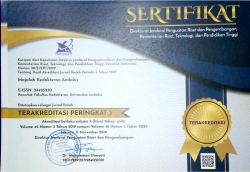AUTOIMMUNE HEPATITIS
Abstract
Abstrak
Hepatitis autoimun merupakan penyakit inflamasi hati yang berat dengan penyebab pasti yang tidak diketahui yang mengakibatkan morbiditas dan mortalitas yang tinggi. Semua usia dan jenis kelamin dapat dikenai dengan insiden tertinggi pada anak perempuan usia prepubertas, meskipun dapat didiagnosis pada usia 6 bulan. Hepatitis autoimun dapat diklasifikasikan menjadi 2 bagian berdasarkan adanya antibodi spesifik: Smooth Muscle Antibody (SMA) dengan anti-actin specificity dan/atau Anti Nuclear Antibody (ANA) pada tipe 1 dan Liver-Kidney Microsome antibody (LKM1) dan/atau anti-liver cytosol pada tipe 2. Gambaran histologisnya berupa “interface hepatitis”, dengan infiltrasi sel mononuklear pada saluran portal, berbagai tingkat nekrosis, dan fibrosis yang progresf. Penyakit berjalan secara kronik tetapi keadaan yang berat biasanya menjadi sirosis dan gagal hati.
Tipe onset yang paling sering sama dengan hepatitis virus akut dengan gagal hati akut pada beberapa pasien; sekitar sepertiga pasien dengan onset tersembunyi dengan kelemahan dan ikterik progresif ketika 10-15% asimptomatik dan mendadak ditemukan hepatomegali dan/atau peningkatan kadar aminotransferase serum. Adanya predominasi perempuan pada kedua tipe. Pasien LKM1 positif menunjukkan keadaan lebih akut, pada usia yang lebih muda, dan biasanya dengan defisiensi Immunoglobulin A (IgA), dengan durasi gejala sebelum diagnosis, tanda klinis, riwayat penyakit autoimun pada keluarga, adanya kaitan dengan gangguan autoimun, respon pengobatan dan prognosis jangka panjang sama pada kedua tipe.
Kortikosteroid yang digunakan secara tunggal atau kombinasi azathioprine merupakan terapi pilihan yang dapat menimbulkan remisi pada lebih dari 90% kasus. Strategi terapi alternatif adalah cyclosporine. Penurunan imunosupresi dikaitkan dengan tingginya relap. Transplantasi hati dianjurkan pada penyakit hati dekom-pensata yang tidak respon dengan pengobatan medis lainnya.
Kata kunci : hepatitis Autoimmune; Aetiopathogenesis; Lymphocyte disease; Cellular immune attack; Histocompatibility lymphocyte antigen, Immunosuppressive therapy, Cyclosporine, transplantasi hati
Abstract
Autoimmune hepatitis is a severe and inflammatory disease of the liver of unknown etiology carrying high morbidity and mortality. All ages and genders are concerned with a peak of incidence in girls in prepubertal age, even if the disease
TINJAUAN PUSTAKA
2
has been diagnosed as early as 6 months. Autoimmune hepatitis may be classified in two major subgroups on a presence of a specific set of autoantibodies: smooth muscle antibody (SMA) mostly with anti-actin specificity and/or by antinuclear antibody (ANA) in type 1 and liver-kidney microsome antibody (LKM1) and/or the anti-liver cytosol in type 2. The histological hallmark is “interface hepatitis”, with a mononuclear cell infiltrate in the portal tracts, variable degrees of necrosis, and progressive fibrosis. The disease follows a chronic but fluctuating course usually progressing to cirrhosis and liver failure.
The most frequent type onset is similar to that of an acute viral hepatitis with acute liver failure in some patients; about a third of patients have an insidious onset with progressive fatigue and jaundice while 10-15% are asymptomatic and are accidentally discovered by the finding of hepatomegaly and/or an increase of serum aminotransferase activity. There is a female predominance in both. LKM1-positive patients tend to present more acutely, at a younger age, and commonly have immunoglobulin A (IgA) deficiency, while duration of symptoms before diagnosis, clinical signs, family history of autoimmunity, presence of associated autoimmune disorders, response to treatment and long-term prognosis are similar in both groups.
Corticosteroids alone or in conjunction with azathioprine are the treatment of choice inducing remission in over 90% of patients. An alternative therapeutic strategy is cyclosporine. Withdrawal of immunosuppression is associated with high risk of relapse. Liver transplantation manages patients with decompensated liver disease unresponsive to “rescue” medical treatment.
Key words: Autoimmune hepatitis; Aetiopathogenesis; Lymphocyte disease; Cellular immune attack; Histocompatibility lymphocyte antigen, Immunosuppressive therapy, Cyclosporine, Liver transplantation.





















